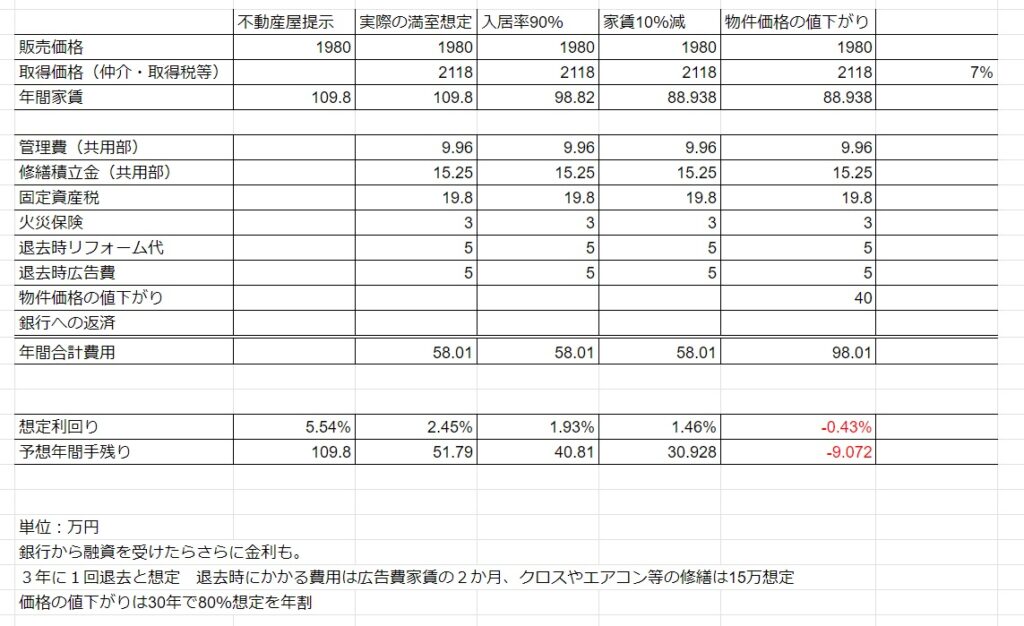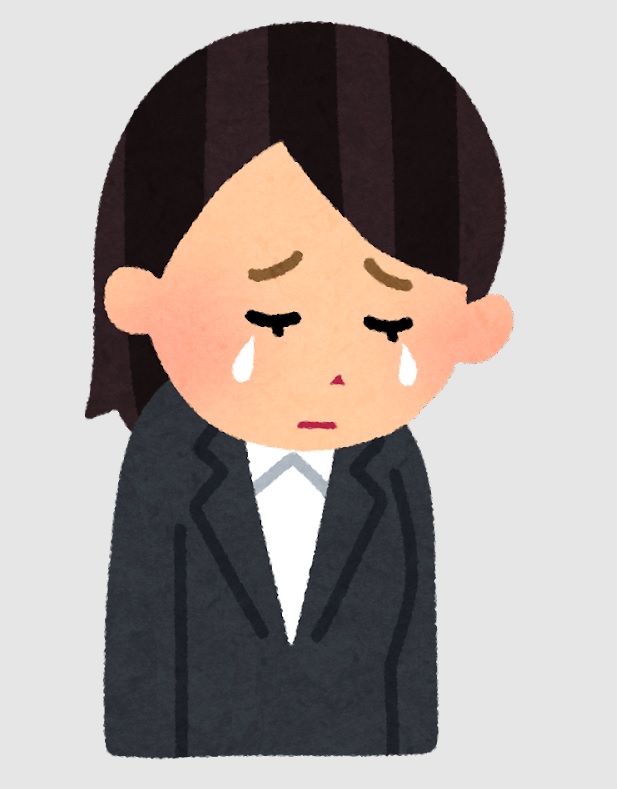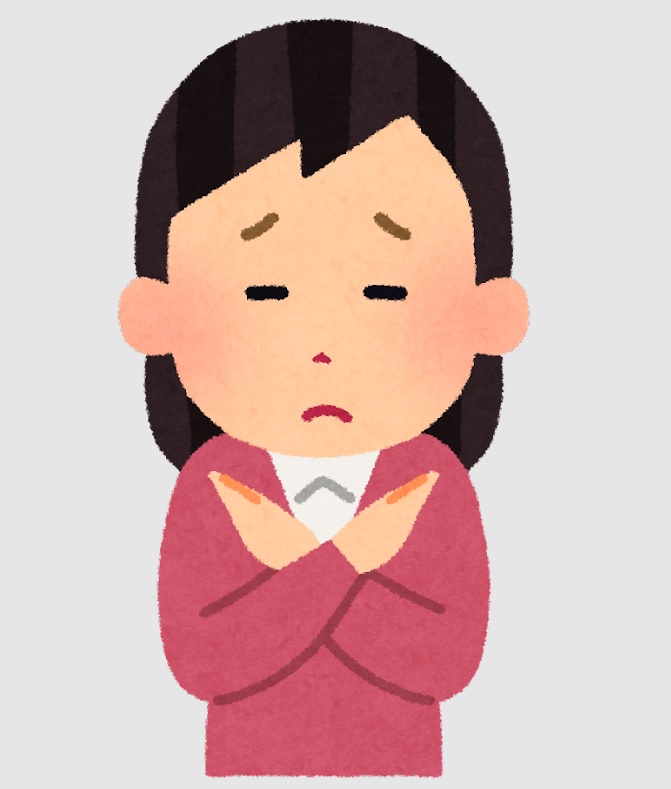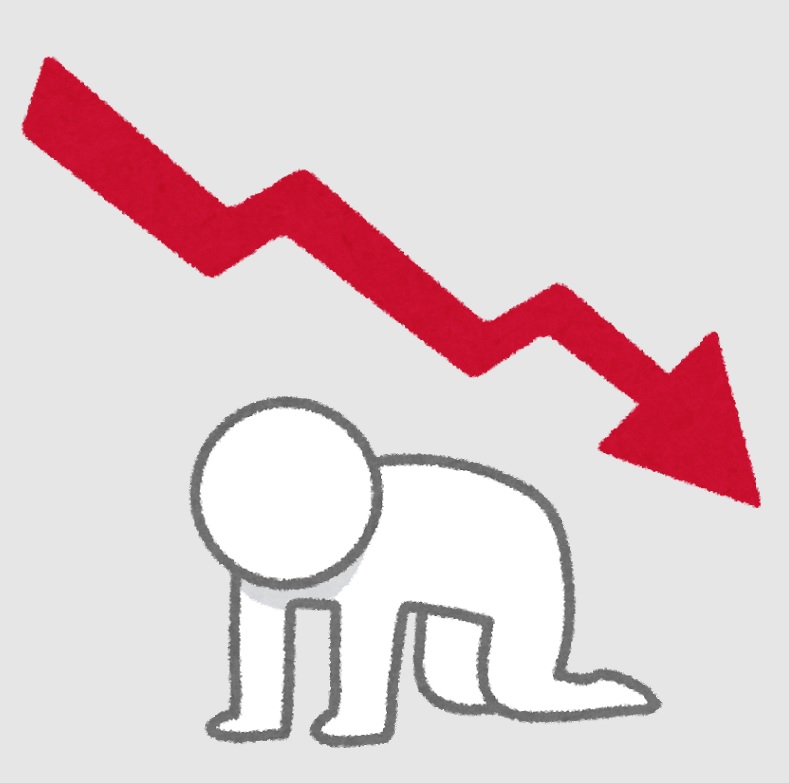「ヒドい|数字の裏に潜むリスクを見抜く!賢い投資家の秘訣」
~前回のつづき~
●失敗する理由(つづき)
例)
10年間で500万円家賃が入るとします。
1000万円で買った物件が
10年間で500万円家賃が入りました。
この物件売った時に
500万円で売れたとします。
もともと1000万円有ったのが
500万円で売れただけだったら
結局一緒じゃないですか。
増えてない。
そこも考えないといけない。
なので表面利回りに騙されてはいけない。
これは不動産で出てくる用語で
「表面利回り」
この言葉は気をつけないといけない。
大体『表面利回り』と書いてありますから。
表面利回りとは何かというと
粗利益のことです。
満室想定の家賃収入を物件価格で割ったもので
いくらでも高く見せかける事が出来ます。
例えば家賃収入。
もらえる家賃が年間100万円で
物件価格が1000万円。
となると表面利回りは10%になります。
満室想定なので
想定家賃収入なので
別に100万円じゃなくても150万円
これで埋まったらねという話で
満室想定なので
これをチョコチョコっと
150万円にしてあげるだけで
表面利回りって
一瞬で15%に増やせるんですよ。
他にも色々増やす方法はあります。
そうやって簡単にいじれちゃう。
だからこの実質利回りは
自分で計算しないといけない。
家賃収入から
必要なコストを全部差し引いた
実態を現す利回り。
自分で考えていかないといけない。
だからこのさっきの
表面利回り5.54%というのは
実質の利回りを考えたら
何%になるのか
実際に計算してみたんですね。

ヒドい。
不動産屋が提示ている利回りは
5.54%ですよね?
販売価格が1980万円で
家賃が9.2万円で
それ以外の管理費とか修繕積立金とか
全く考えない状態で
予想年間手残りが110万円まるまる残ると。
それで想定利回りが5.54%。
こんな事ありえないです。
実際の満室想定で出してみました。
販売価格が1980万円かもしれませんが
物件取得価格がかかる。
仲介料と不動産取得税
大体140万円ぐらいかかるんですね。
7%ぐらい大体かかる。
それで2100万円以上かかる。
それから
・管理費
・修繕積立金
・固定資産税
・火災保険
そういうのを入れていく。
それぐらい入れていくと
想定利回りが2.45%になるんですよね。
予想年間手残りが約52万円になる。
これ全部キャッシュで買った場合ですからね。
2118万円銀行から借り入れせずに
キャッシュで買った場合。
それで2.45%で52万円ぐらい残る。
これぐらいだったら
銀行に預けておくよりいいかな?と
0.01%金利が付くより
2.4%以上増えるのであれば・・・
と思うかもしれませんが
ちょっと待ってください。
まず入居率ですよね。
空室率というのを全く考えられてないんですよ。
30年間全く誰も退去せずに
埋まり続ける事はありません。
退去時のリフォーム代とか
退去時の広告費というのは
毎年はかかるものではないですが
一応退去が出るたびにかかります。
数年に一回掛かってくるものなので
それも年割して大体載せてる。
それで入居率が90%だと。
・10%落ちてしまった場合
・満室じゃなかった場合
30年間ずっと満室なんてありえないので
それで計算してみると
年間の家賃が当然10%下がる訳です。
でもそれ以外は変わらない。
その状態で手残りが
41万円に今度は減った。
これでもいいかなぁって
思う人がいるかもしれませんが
家賃がずーっと同じ価格で
取り続けられる事はまずありません。
30年間家賃が下がらない訳がない。
だって築15年のマンションが
30年経ったら築45年ですよ。
築45年のマンションを
見てみて欲しいんですけど
結構ボロボロですよね?
その状態で築10年くらいの時の
家賃と全く同じ価格の家賃を
取れるなんてありえない。
家賃10%落ちたとして
その計算ですると今度は
・想定利回りが1.46%
・手残りが31万円
になってくる。
これでもいいと言うかもしれませんが
家賃10%で入居率90%ですからね。
実際にはもっと多分下がってきますね。
家賃10%減じゃ済まないでしょう。
~~~つづく~~~
Special Thanks college president Ryo.
●おまけ
≪≪Chat-GPTくんによる要約→perplexityちゃんによる文章まとめ≫≫
不動産投資においては、表面利回りと実質利回りの違いを理解することが重要です。
表面利回りは年間家賃収入を物件価格で割ったもので、簡単に計算できますが、諸経費や空室率を考慮していないため、実際の収益性を正確に反映していません。
例えば、表面利回りが5.54%の物件でも、実質的には管理費や修繕積立金、税金などを加味すると2.45%程度に下がることがあります。
さらに、空室率や将来の家賃下落を考慮すると、実質利回りはさらに低下する可能性があります。
したがって、投資判断を行う際には、表面利回りに惑わされず、実質利回りを自分で計算することが不可欠です。
長期的な視点で、物件の経年劣化に伴う家賃の変動も考慮する必要があります。
これにより、より現実的な投資判断ができるようになります。
≪≪Chat-GPTくんによる英訳≫≫
~Continuation from the last time~
● Reasons for failure (continued)
Example:
Suppose you receive 5 million yen in rent over 10 years.
You bought a property for 10 million yen, and over 10 years you received 5 million yen in rent.
Now, let’s say you sell the property for 5 million yen.
Originally, you had 10 million yen, but you only sold it for 5 million yen, so you’re back to square one.
Nothing increased. You need to think about that.
Therefore, you shouldn’t be fooled by the “gross yield.”
This is a term often used in real estate: “Gross Yield.”
You need to be cautious with this term.
It usually says “gross yield.”
What is gross yield? It’s the gross profit.
It’s calculated by dividing the expected rental income at full occupancy by the property price, so it can be made to look as high as you want.
For example, rental income.
If the expected rental income is 1 million yen per year and the property price is 10 million yen,
the gross yield becomes 10%.
But this is based on the assumption of full occupancy and expected rental income, so even if it’s not 1 million yen, but 1.5 million yen,
this assumes that if it’s fully occupied,
just by tweaking this to 1.5 million yen,
the gross yield can instantly increase to 15%.
There are other ways to increase it as well.
So, it can be easily manipulated.
Therefore, you need to calculate the actual yield yourself.
The real yield reflects reality, after subtracting all necessary costs from the rental income.
You have to think about it yourself.
So, when I calculated what the actual yield would be,
compared to the gross yield of 5.54%,
it was quite shocking.
The yield presented by the real estate agent was 5.54%, right?
The selling price was 19.8 million yen, and the rent was 92,000 yen.
This calculation didn’t take into account management fees, reserve funds for repairs, or anything else, so the expected annual net income was assumed to be a full 1.1 million yen.
That’s how they got the estimated yield of 5.54%. This is unrealistic.
I recalculated based on full occupancy. Even though the selling price was 19.8 million yen, acquisition costs are required.
Brokerage fees and real estate acquisition taxes typically cost around 1.4 million yen, which is about 7%.
So, the total cost exceeds 21 million yen.
Then, when you factor in:
・Management fees
・Reserve funds for repairs
・Property taxes
・Fire insurance
Once all of that is factored in, the estimated yield drops to 2.45%.
The expected annual net income becomes about 520,000 yen.
This is assuming you bought it entirely with cash.
If you bought it with 21.18 million yen in cash, without borrowing from the bank,
you’d be left with around 520,000 yen at a 2.45% yield.
At this level, it might seem better than leaving your money in the bank, right?
If you can get a 2.4%+ return instead of a 0.01% interest rate…
But wait a minute.
First, consider the occupancy rate.
The vacancy rate isn’t being considered at all.
There’s no way a property will remain fully occupied for 30 years without anyone moving out.
You also have to consider renovation costs and advertising fees when tenants leave.
Although these costs don’t occur every year, they do come up every time someone moves out.
These are costs that come up every few years, so I’ve factored them in on an annual basis.
Assuming an occupancy rate of 90%:
・If the rate drops by 10%
・If it’s not fully occupied
It’s impossible for a property to be fully occupied for 30 years, so when you calculate this, the annual rent naturally decreases by 10%.
But other costs remain unchanged.
In this scenario, your net income now drops to 410,000 yen.
Some people might still think this is okay,
but rents never stay the same for 30 years.
There’s no way rent won’t decrease over 30 years.
For example, a 15-year-old apartment will be 45 years old after 30 years.
Take a look at a 45-year-old apartment—it’s often quite run-down, isn’t it?
There’s no way you could charge the same rent as when it was only about 10 years old.
Even if the rent drops by 10%, if you calculate it,
now:
・The estimated yield becomes 1.46%
・The net income drops to 310,000 yen
Even then, some might say it’s acceptable,
but this is with a 10% rent drop and 90% occupancy rate.
In reality, the figures will likely drop even further. A 10% rent drop probably won’t be the end of it.
Special Thanks OpenAI and Perplexity AI, Inc


